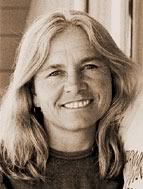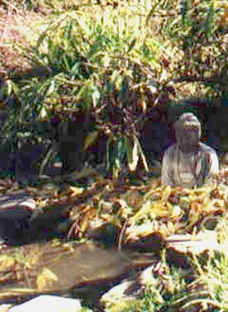PERMACULTURE: California Style
An Interview with Penny Livingston
JANUARY 2003
(Originally recorded April 18, 2000)
Part two of a three-part series - page 2 of 2
ECOTECTURE: Let say that you could have the future as you wanted it—a Permaculture future. If you think about large cities with many, many people to feed, issues of things being out of balance. Would it be forty acres and a mule, or one acre and a mule where everybody has a little place like yours and feeds themselves? Or would it be communal design?
LIVINGSTON: That is where you look as scale linking. That is a very important question, especially in regard to population. You have to look at diversity. Diversity in settlements is equally important (as biological or cultural diversity.) I would never say, "everybody has to live in the city. Everybody has to live in the suburbs. Everybody needs to go out and get his back forty somewhere." We need all of it. We can't have every single person living in the city any more than we can have every single person living out of the city. What we need is a diversity of scale so we have the mixed use inner city corridors with green belts running through them and greenhouses.
|
|
There are urban designs with greenhouses on the south walls of every building and there was the potential to not only grow, but process your own food and your own gray water. Actually recycle the water within the building using it for heating and growing food in the greenhouse and for other purposes. Again, when you get an integrated design, it gets very exciting. I want to see somebody actually pull it off, and take the risk money.
I don't want to digress too much, because I want to go back to the vision. But, one of the ways that this could be accomplished is if some of these people who are hoarding some of the great wealth of this country, as well as anywhere else, actually took that money and threw it at somebody to do a design and to construct the archetypal development, or one example of an archetypal development. Yet that money would be 100 percent risk money. They may never see it again. Yet it would do so much good to be able to see such an example. Because right now those kind of systems, those infrastructures in the city are expensive. I think in the long term they will end up being a lot less expensive. They'll certainly end up being a lot less ecologically expensive. But, until we have the technology and the knowledge of how to build these things, it is going to cost somebody. You can't expect the builder to donate all his time to figuring it all out and scratching his head, any more than you can expect the engineers to do that. But there are people who are hoarding money. If they could pay these people to put their heads together to come up with an integrated design . . . we know we have the technology. We know what to do.
My dream would be to be able to work with a really good engineer, builder, and energy person and design a complex. Not just a house, a building, but a whole living center that includes living units, shopping units, commercial, residential, inner city, high density space that is totally cutting edge. I think there are some things on the drawing board, but I would like to know where to go to visit something like that.
The city could become so much more efficient, if it so desired. I know we have the technological knowledge to do that, but I don't know that we have the political will. Or the educated . . . . some of us have the education to do that, and some of us don't. It is a matter of putting together some kind of common vision, and that can be a broad, conceptual common vision, just recognizing that we can't just keep doing things the way we have been.
The cities can grow their own food. There is no reason why anybody in a city can't be fed from within that city, or at least from a greenbelt around the city. Functional trees . . . . You know, I drove into San Francisco the other day, to go on a little rant, tirade . . . Have you seen all the palm trees they are putting up?
| What we need is a diversity of scale so we have the mixed use inner city corridors with green belts running through them and greenhouses. |
ECOTECTURE: No. The ones by the Marina? I read about them in the paper.
LIVINGSTON: Do you know how much those palm trees cost?
ECOTECTURE: Ten thousand apiece, or something like that.
LIVINGSTON: Something like that. What does it say for the City? Are we trying to be a Santa Barbara wannabe, or what? Those palms have nothing to do with this place, and they are phenomenally expensive. Meanwhile, bus rates are doubling and the schools are going to hell. But the City somehow manages enough money to put that in? I'm actually shocked.
This is the type of thing we must start looking at. Who is running the show here? How is it that that decision gets made, there are abandoned buildings, and all those homeless people don't even have a pot to piss in. Excuse me, don't quote me on that. Don't even have a roof over their head. I get just . . . it is beyond getting angry. I get incredulous.
That is what management is. Whoever is pulling the strings in urban areas—San Francisco is just one pathetic example—but this is happening all over the place, and we talked before this interview about the gentrification of poorer neighborhoods. People coming in and real estate values going up. It is turning our whole existence into a commodity. What is up with that? When is it going to end? Where is the boundary going to be?
Obviously they transcend the boundary with genetic engineering, that they can patent and sell life. They can patent and sell your DNA that you created in your own blood. They make profits on it. They have patented our food supply. We have lost 97 percent. That is not an exaggeration. Ninety-seven percent of our food crops have been lost in the last one hundred years.
| But, the city could be a beautiful, joyous, sublime, wonderful place to be. A place that breeds community, not isolation, that takes care of every single citizen in that city, that reduces or, hopefully, eliminates the need for crime. |
ECOTECTURE: Lost in what sense?
LIVINGSTON: Lost in the sense of extinction and lack of biodiversity, different varieties of seeds not being used any more. This is mainly because of the agricultural practices we have of monoculture. If you don't use a seed for ten to 20 years, its viability is gone. That has happened to 97 percent of our food crops. It is astounding. There is a movement afoot, now, to bring back that diversity with heirlooms, and try, but 97 percent is a pretty high figure. That figure came from the people who are actually working on trying to protect these things, especially the heirloom vegetables, and who are devoting their lives to creating more diversity on the planet.
There is serious stuff going on, and we are planting $10,000 palm trees in a place where it is totally inappropriate. That's is the problem, right now. The solution is that somehow as a society we have to get our heads together and start to use them, use what we have been given, and to start redesigning and redefining the city. It is possible. It is totally possible. It is just improbable, at this point. I am not hopeful.
But, the city could be a beautiful, joyous, sublime, wonderful place to be. A place that breeds community, not isolation, that takes care of every single citizen in that city, that reduces or, hopefully, eliminates the need for crime. When you start looking at what is the root of crime, why one human wants to do something bad to another human for their own personal gain, what does that need come from? It is all there. All that information and all those ideas have been worked and reworked and reworked, but everybody has been doing it in isolation. They have the psychologist or the crime-ologist talking about crime. They have the other person talking about poverty, somebody else talking about starvation, and somebody else talking about economic opportunity, but they are not all talking to each other. Until that happens, nobody can (move forward.)
Then enter in design, architecture, infrastructure, the opportunity for somebody to simply park his or her bod on the planet. That has been taken away from us. That is a basic right. What is happening with this society that we are searching for the proverbial dollar while people are dying in the streets? It is unfathomable. I don't know of any other species that does this, that works this way. I don't know any other species that kills their own children, basically. It is through that . . . I can go down a pretty deep, slippery slope, but it is Permaculture, and the idea of what it has to offer humanity that keeps me going.
Otherwise I could talk . . . . . I really get a sardonic pleasure out of scaring students with some of the current statistics. But, you know, that isn't productive. (Laughs) But it is there.
ECOTECTURE: It is there.
LIVINGSTON: So Permaculture is important stuff and it is good stuff and it is stuff full of light and hope.

